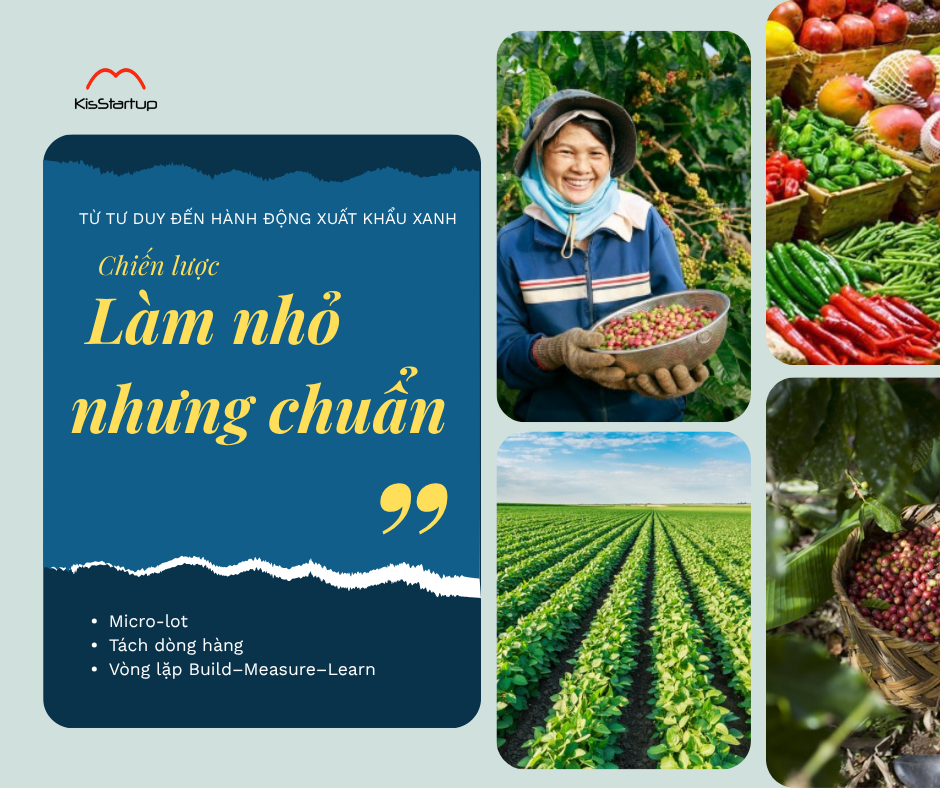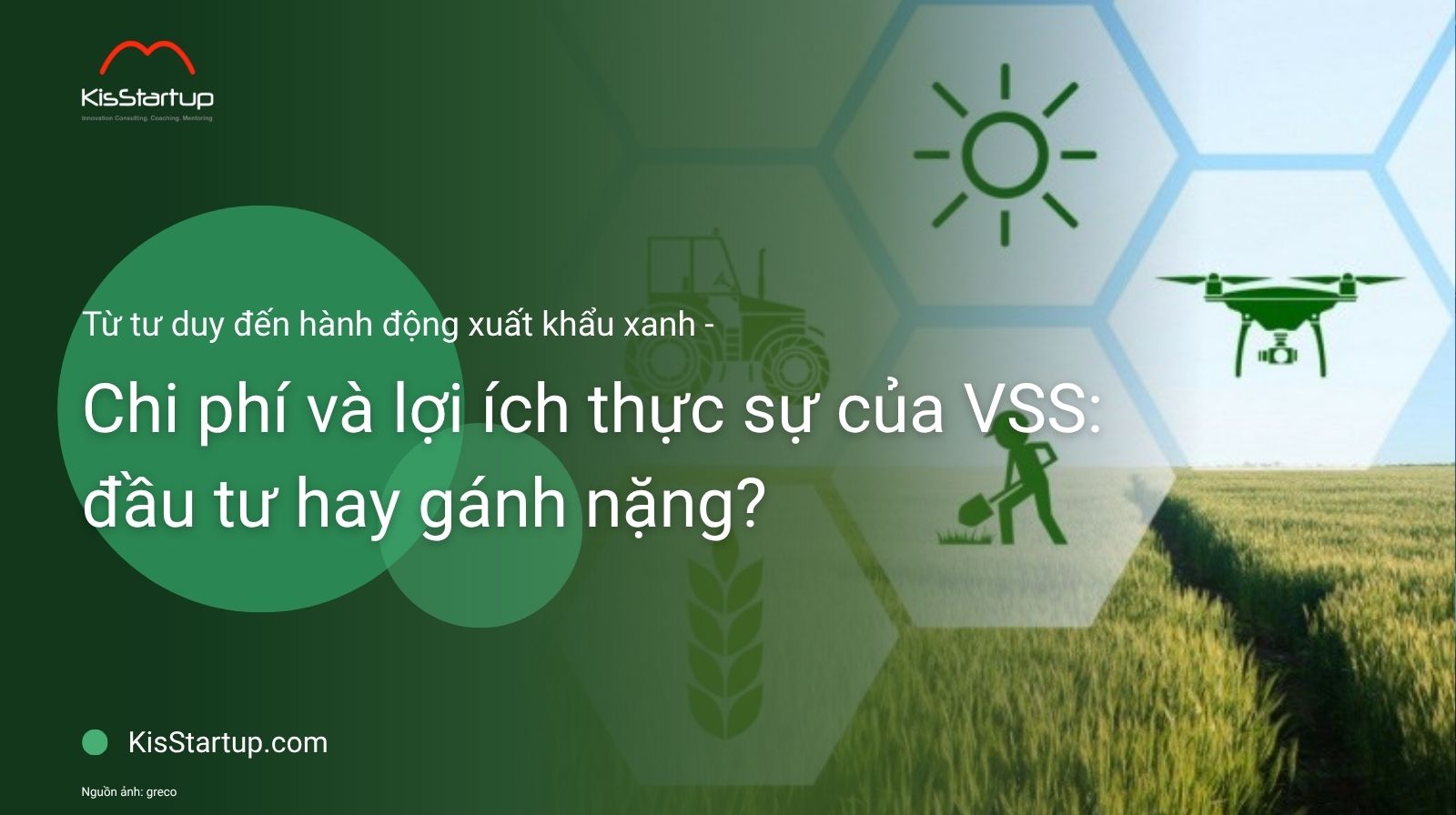From Mindset to Action for Green Export – Part 5: The “Small but Standard” Strategy – Micro-lot, Product Stream Segregation, and the Build–Measure–Learn Loop

Under limited resources, converting an entire farming area or factory to meet Voluntary Sustainability Standards (VSS) at once can drive up costs and risks significantly. The lean startup mindset offers a more sustainable path: start small with a micro-lot (5–10% of output), segregate product streams to prevent mixing, learn by doing, collect real data, and then scale selectively. This aligns with the Build–Measure–Learn principle: instead of lengthy planning, build a “minimum viable product” (MVP) — a pilot batch — measure technical, commercial, and impact indicators, and learn to adjust or pivot before scaling. This approach, systematized in Lean Startup, has proven effective in reducing waste and accelerating market fit.
Micro-lot: A Laboratory for New Business Models
In the specialty coffee industry, a micro-lot refers to a traceable, segregated batch — distinct in origin and process. Its value lies not in size but in controlled, consistent, and transparent management — enabling storytelling, pricing experiments, and new customer relationships.
In supply chain terms, a micro-lot only adds value when its identity is preserved throughout: physical segregation, dedicated records and logs, batch labeling, and controlled handovers — the logic behind identity preservation, segregation, and traceability in agri-food systems.
Segregation: Turning Data into Assets
“Segregation” is essential to prevent micro-lots from dissolving into bulk commodities. Traceability frameworks like ISO 22005 and GS1 GTS emphasize systems for recording and linking each node in the chain to specific batches. Simply put: no segregation, no traceability; no traceability, no value differentiation.
With new regulations such as the EUDR requiring plot-level geolocation and recordkeeping, segregation becomes a must-have for market access. It should be seen not as a cost, but as an investment in data assets that strengthen buyer negotiations.
Micro-lot as an MVP in the Build–Measure–Learn Cycle
Build – Identify a manageable lot (5–10% output) with uniform variety, ripeness, and process. Design a short SOP, assign batch codes, allocate separate storage, and record in simple digital logs (Google Sheets/Excel). This is your MVP — small, distinct, and low-cost to test and learn quickly.
Measure – Select a minimal set of indicators in three layers:
- Technical: moisture/defect rate, MRL/microbiology test results, SOP compliance rate.
- Commercial: offer vs. accepted price, deal closure speed, contract terms.
- Impact/ESG: water/fertilizer reduction, PPE use, farmer feedback.
Focus on actionable metrics — numbers that drive decisions — not vanity statistics.
Learn – Compare unit price differentials, added costs, and risk reductions between micro-lots and bulk batches. If results fall short, pivot: target a new customer segment, adjust processing, or refine the product story and packaging. The B–M–L loop helps avoid “big spend first, lessons later.”
Premium Potential: “Different Enough” and “Clean Enough”
Evidence from specialty markets shows genuine potential: micro-lot prices often exceed local or bulk prices by 74–327%. Yet, premiums aren’t automatic — they depend on sensory quality, traceability storytelling, and batch uniformity.
Still, the “tuition cost” must be acknowledged: segregation reduces blending flexibility and raises management costs. The premium must offset this loss — a reality highlighted by coffee market analysts.
Designing Micro-lots as Business Model Experiments
A micro-lot is a sandbox for testing all business model variables:
- Customer segment: experiment with direct sales to roasters or high-end chains instead of bulk traders.
- Value proposition: offer “uniform–traceable–ESG story” instead of “cheap–fast.”
- Channels & relationships: small but recurring contracts; season-on-season improvements; price differentiation by quality score.
- Revenue & cost structure: separate accounting to identify the “premium break-even point.”
- Impact (E–S–G): measure water savings, reduced chemical use, safety improvements, and data credibility.
This design fits Lean philosophy: test fast – learn fast – iterate fast instead of perfect plans first.
Suggested 90–180–360-Day Roadmap
- 90 days: select a micro-lot; create short SOPs, batch codes, and separate storage; log data and photos via Google Sheets/Excel for collaboration.
- 180 days: measure key indicators (technical, commercial, impact); conduct representative lab tests (MRL/microbiology); test tiered pricing with 2–3 buyers.
- 360 days: review the B–M–L loop; scale selectively (from 5–10% to 20–30% of output) if premium–risk–cost results are positive; align with ISO 22005/GS1 standards for full traceability and VSS readiness.
Common Risks & Mitigation
- Micro-lot without segregation: loss of identity → loss of premium. → Solution: strict labeling, separate storage, handover documentation per ISO 22005/GS1.
- Tracking vanity metrics: attractive numbers that don’t guide action. → Solution: focus on 5–7 actionable indicators tied to pricing, volume, or cost decisions.
- Premium not offsetting costs: weak story or quality differentiation.→ Solution: improve process, pivot customer segment, or refine product/packaging.
Micro-lot and segregation are not just technical measures — they reflect a Lean experimentation mindset: Build–Measure–Learn. Start small to learn fast; standardize data and processes for reliability; scale up with evidence. When micro-lots deliver measurable differentiation, firms both unlock premiums and shorten their path to VSS compliance — since the hardest part (data discipline and traceability) is built from day one.
References
Blank, S. (2013). Why the lean start-up changes everything. Harvard Business Review.
https://hbr.org/2013/05/why-the-lean-start-up-changes-everything (Harvard Business Review)
Blank, S. (2013). Free reprints of “Why the Lean Startup Changes Everything”. Steve Blank Blog.
https://steveblank.com/2013/05/06/free-reprints-of-why-the-lean-startup-... (Steve Blank)
ISO. (2007). ISO 22005:2007—Traceability in the feed and food chain.
https://www.iso.org/standard/36297.html (ISO)
ISO. (2007). ISO 22005:2007 (online browsing platform) — principles & requirements.
https://www.iso.org/obp/ui/ (ISO)
GS1. (2021). GS1 Global Traceability Standard (GTS).
https://www.gs1.org/standards/gs1-global-traceability-standard/current-s... (GS1)
GS1. (2017). GS1 Global Traceability Standard (PDF).
https://www.gs1.org/sites/default/files/docs/traceability/GS1_Global_Tra... (GS1)
European Commission. (n.d.). Traceability and geolocation of commodities subject to EUDR.
https://green-forum.ec.europa.eu/nature-and-biodiversity/deforestation-r...
Driven Coffee. (2024). What is microlot coffee, and what makes it special?
https://www.drivencoffee.com/blogs/blog/what-is-microlot-coffee (Driven Coffee)
Perfect Daily Grind. (2020). What is a micro lot in specialty coffee?
https://perfectdailygrind.com/2020/04/what-is-a-micro-lot-in-specialty-c... (Perfect Daily Grind)
Coffeelands/CRS. (2013, June 26). The economic impacts of microlots.
https://coffeelands.crs.org/2013/06/367-the-economic-impacts-of-microlots/ (coffeelands.crs.org)
Daily Coffee News. (2013, June 26). Exploring the economic impacts of microlots….
https://dailycoffeenews.com/2013/06/26/exploring-the-economic-impacts-of... (Daily Coffee News by Roast Magazine)
Oilslick Coffee. (2023, June 18). Microlots (Coffee Prices: The Big Fix).
https://oilslickcoffee.com/economics/market/coffee-the-big-fix/ (Oil Slick Coffee)
Smyth, S., & Phillips, P. (2002). Product differentiation alternatives: Identity preservation, segregation, and traceability. AgBioForum, 5(2), 30–42.
https://agbioforum.org/wp-content/uploads/2021/02/AgBioForum_5_2_30.pdf (agbioforum.org)
Google Support. (n.d.). Share & collaborate on a spreadsheet.
https://support.google.com/a/users/answer/13309904
Microsoft Support. (n.d.). Collaborate on Excel workbooks at the same time with co-authoring.
https://support.microsoft.com/office/7152aa8b-b791-414c-a3bb-3024e46fb104 (Harvard Business Review)
(Tài liệu bổ trợ: PECB/ISO 22005 overview; GS1 chain-of-custody & DSCSA để tham chiếu mô hình truy xuất/segregation trong các chuỗi khác). (PECB)



